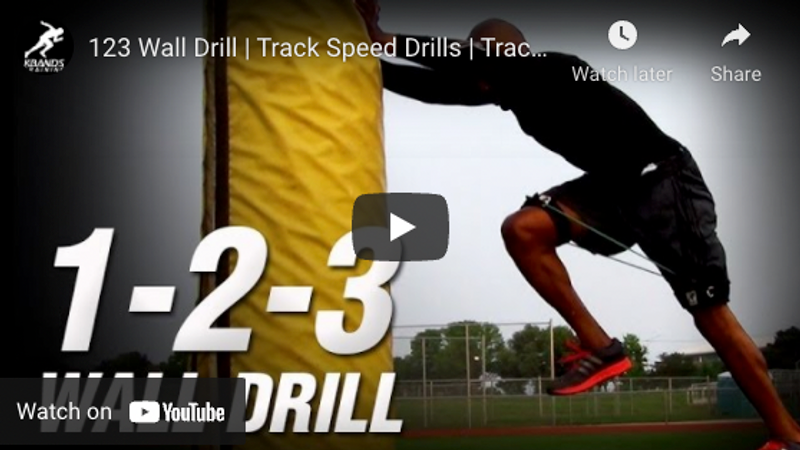123 Wall Drill: Track and Field Workout
Strong performance on the track requires a quick start and steady, explosive propulsion, and both of these begin in the hip flexors. But without plantar flexion, knee drive, and control of the core, runners can only progress so far. Since serious and successful speed training involves more than just hip strength and muscle memory, straight runs and sprint drills aren’t quite enough to round out a complete program. With that in mind, a comprehensive set of track and field workouts should also incorporate targeted strength training and wall drills like the one demonstrated in this video.
During this speed training drill, runners will be able to place the demands of sprinting aside for the moment (such as balance and upper body control) and focus fully on conditioning in the core and through the drive zone. This drill won’t require much equipment, but it will demand a degree of endurance and concentration. Coaches and track athletes can work this speed training set into their regular seasonal regimen once or twice per week for maximum results.
Speed Training With the 123 Wall Drill: Setting Up the Drill
This drill can be executed against a flat wall, or as in the video, against a padded goal post. But regardless of the environment (wooded trail, indoor gym, etc), the post should be sturdy, the ground below should be flat, and runners should have plenty of room to drive the knees up and forward.
Each athlete will also need a set of Kbands resistance training bands, which are available for purchase at Kbands Training.com, and of course a regular set of workout gear including appropriate shoes.
Speed Training With the 123 Wall Drill: Executing the Drill
This speed training drill takes place in two phases: The initial phase and the consistent phase.
The Initial Phase
Once the Kbands are strapped in place and the track athlete is leaning against the support post with both hands planted above the head, the first phase can begin. The athlete will raise each knee in fast succession in three-beat rhythm followed by a pause. Each repetition of three explosive knee drives will end with a pause about as long as the 123 phase, and during this pause, the front knee will stay elevated.
During this phase, athletes should focus on driving the front knee up to a high position and challenging the toe. The toe will need to be very high at the beginning of the stride in order to load the calf muscle. When leg comes down from the lift position and enters the dig phase, a higher, stronger toe will supply more explosive energy to the calf muscle and give the next stride an explosive advantage.
This phase can be repeated in a three-beat rhythm for ten to twelve seconds, followed by a pause of a minute and a half. As each ten or twelve second round is underway, athletes should be investing fully in leg position, foot position, knee drive, and maintaining the overall body line at a 45 degree angle.
The Consistent Phase
After several rounds of three-beat strides, athletes can move into the consistent phase. This will involve the same basic body motion and position, but instead of three beats followed by a pause, runners will drive the knee up in a continuous, explosive motion for the entire ten to twelve second period or about six reps. After ten to twelve seconds, athletes can pause and rest for a minute and a half before launching into the set again.
Speed Training with the 123 Wall Drill: Technique
As athletes complete this drill with the Kbands resistance training bands in place, they’ll need to keep a few key aspects of the bands in mind. First, the higher level of resistance will require athletes to take active control over the motion and the entire exercise. The bands should not be allowed to constrict the stride and control the motion—Instead, athletes will need to work hard against the resistance in order to maintain drive and height in the knee.
After a full round of six 123 reps, a full rest period, then another round of six ten to twelve second sets of continuous strides, athletes can move into a final phase of un-resisted sets. The bands can be removed or unclipped from the Kbands straps around the upper legs and the sequence can start over from the beginning with no artificial resistance in place.
During the unresisted sets, athletes will feel a temporary neurological sensation of extreme lightness, which will make the knees feel higher and the feet feel faster. But again, athletes should work hard to stay in control of the motion and not let this temporary sensation control body position or technique.
Coaches can provide assistance during this drill by observing players to make sure their body position stays aligned. They can also offer necessary pointers on the energy athletes invest in knee drive and foot position during each take-off and landing. High energy and complete rest periods will be essential to the success of this speed training drill.
Speed Training: Final Notes
This drill represents just one of a larger catalogue of speed, flexibility, strength training and conditioning drills targeted toward track and field athletes at all skill levels. For more drills like this one, track athletes and coaches can visit Kbands Training. com and explore the track and field section of the website. The site also offers a large collection of sport-specific training drills for football, basketball, baseball, cheer, soccer, and lacrosse.

